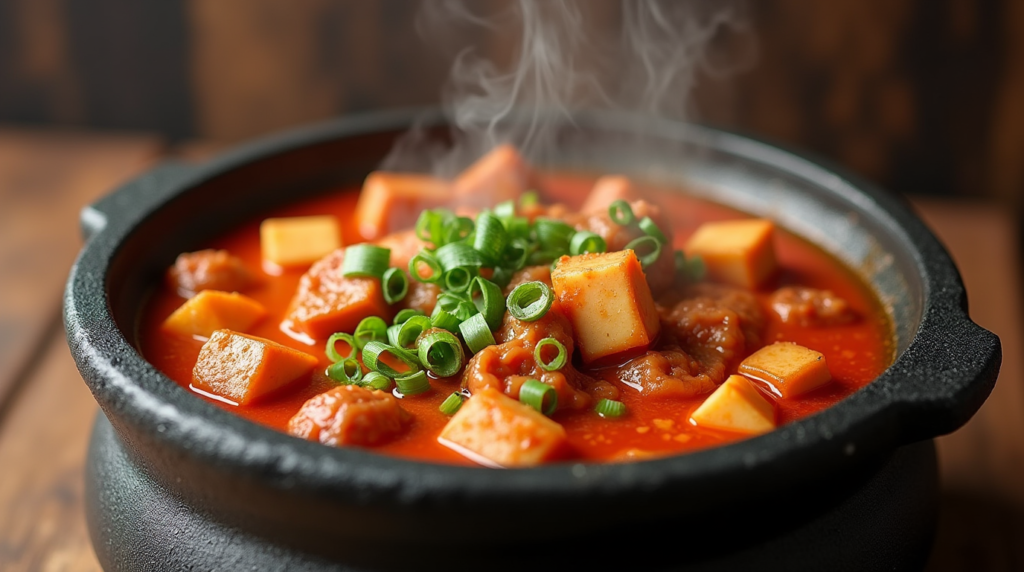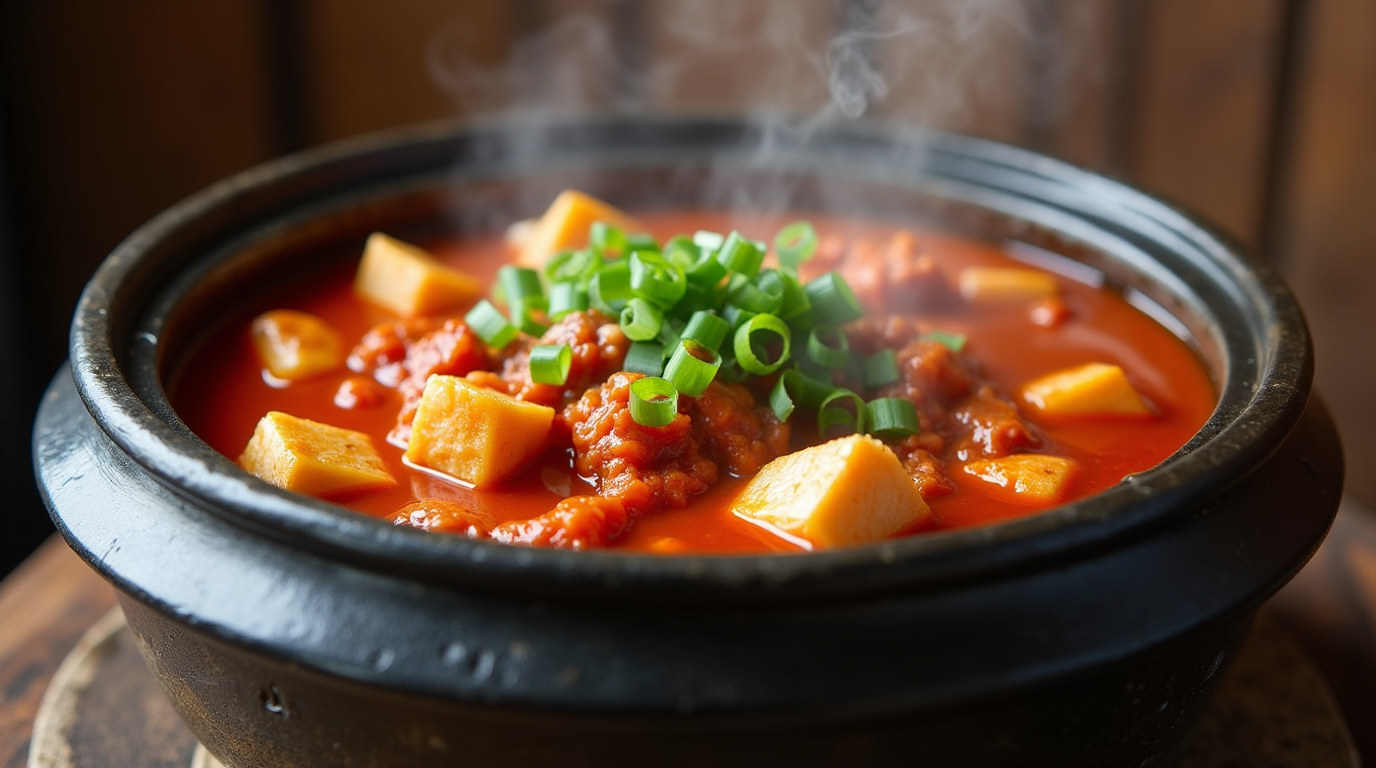Kimchi Jjigae: A Comforting Korean Soup for Every Season
There’s something magical about a steaming bowl of kimchi jjigae, especially when it’s served hot on a chilly day or when shared among friends and family. This iconic Korean stew, made from kimchi, tofu, and savory seasonings, is a dish that not only fills your stomach but also nourishes your soul. Whether you’re already a fan of Korean cuisine or new to its rich flavors, kimchi jjigae is a dish you absolutely need to try. Let’s explore what makes this dish so unique, how to make it at home, and why it has earned its spot as a comfort food staple.
What is Kimchi Jjigae? A Brief Introduction
Kimchi jjigae is a traditional Korean stew that revolves around kimchi, a fermented vegetable dish that’s beloved for its unique combination of spicy, sour, and umami flavors. In this stew, the kimchi is simmered with tofu, vegetables, and sometimes meat, creating a hearty, comforting dish. The rich broth combines the tangy flavors of fermented kimchi with a variety of seasonings to create a balanced and flavorful stew.
Historically, kimchi jjigae emerged as a humble yet nutritious dish in Korean households. It was often made with leftover kimchi, turning it into a savory meal that could be enjoyed with rice. Over the years, it has evolved into a beloved dish that represents Korean comfort food and is often served as a family meal or a dish to share with friends.
The Main Ingredients of Kimchi Jjigae
Kimchi jjigae owes much of its distinctive flavor to its main ingredients. While the variations are plenty, these ingredients remain key to making an authentic and satisfying stew.
Kimchi: The Heart of the Dish
The foundation of kimchi jjigae is none other than kimchi itself. This fermented vegetable dish is made with napa cabbage or radishes, seasoned with chili flakes, garlic, ginger, and fish sauce, and allowed to ferment over time. As it ages, kimchi develops a tangy, slightly sour flavor that adds depth to the stew. For the best flavor, it’s important to use well-fermented kimchi, as it imparts a more complex taste to the broth.
Tofu: Adding Texture and Protein
In addition to kimchi, tofu plays a crucial role in the dish. Firm tofu, cut into cubes, absorbs the rich flavors of the broth while adding a soft, creamy texture to balance out the spiciness of the kimchi. Tofu is an excellent source of plant-based protein, making it a perfect addition for vegetarians and vegans.
Pork, Beef, or Other Protein Options
While tofu is commonly used, kimchi jjigae is often made with pork belly or beef, which gives the dish a deeper, meatier flavor. Pork belly is especially popular for its tender, fatty texture, which melts into the broth, enriching it. You can also use other meats or proteins based on your preference. For a plant-based version, mushrooms make a great alternative, providing an earthy, savory note to the stew.
Vegetables and Seasonings
Other essential ingredients include onions, garlic, and green onions, which form the base of the broth and contribute layers of aromatic flavors. Gochujang (Korean chili paste) and gochugaru (Korean chili flakes) bring the signature heat and depth to the dish. A splash of soy sauce or fish sauce enhances the savory umami, and a drizzle of sesame oil adds a subtle nuttiness that ties everything together.
How to Make Kimchi Jjigae: A Step-by-Step Guide

Making kimchi jjigae is a straightforward process that can be completed in about 45 minutes. Here’s how you can make it at home and enjoy a bowl of comforting Korean stew in no time.
Preparing the Ingredients
Before you begin, gather all your ingredients. Fresh, well-fermented kimchi is essential for the best flavor. Slice the pork belly or tofu into bite-sized pieces and chop your vegetables, including onions, garlic, and green onions. Have your seasonings ready and within reach.
Cooking Method
Step 1: Sauté the Pork or Beef with Garlic and Onions Begin by heating a pot over medium heat. Add the sliced pork belly or beef, sautéing it until browned. Add garlic and onions to the pot, stirring them until they’re softened and fragrant.
Step 2: Add the Kimchi Once the meat is browned and the onions and garlic have softened, add the kimchi to the pot. Stir it around and cook it briefly, allowing the kimchi to release its juices and become slightly caramelized.
Step 3: Add Tofu and Seasonings Now, it’s time to add the tofu and seasonings. Pour in water or broth to create the stew base, then stir in gochujang, gochugaru, soy sauce, and fish sauce. Bring the mixture to a boil, then lower the heat to a simmer.
Step 4: Simmer and Serve Let the stew simmer for 30 minutes, allowing all the flavors to meld together. Add green onions and a drizzle of sesame oil just before serving for a fresh, aromatic finish.
Tips for Perfecting Kimchi Jjigae
- Timing: Allow the stew to simmer for at least 30 minutes to ensure the flavors develop fully.
- Adjusting Spice Level: If you’re sensitive to spice, start with a smaller amount of gochujang and gochugaru, and adjust to taste.
- Leftovers: Kimchi jjigae actually tastes even better the next day, as the flavors continue to deepen. Make extra and store it in the fridge for later!
Kimchi Jjigae Variations: Exploring Different Flavors
One of the beauties of kimchi jjigae is its versatility. You can easily customize the dish based on your dietary preferences or available ingredients.
Vegetarian and Vegan Kimchi Jjigae
If you prefer a plant-based version of kimchi jjigae, simply omit the meat and focus on tofu or mushrooms. Shiitake mushrooms, in particular, add a wonderful umami flavor that mimics the richness of meat. The stew will still be hearty and satisfying without the animal proteins.
Spicy vs. Mild: Customizing Your Kimchi Jjigae
Kimchi jjigae can be as spicy or as mild as you like. If you enjoy heat, use more gochujang and gochugaru to amp up the spice. For a milder version, reduce the chili paste and chili flakes or opt for a less spicy kimchi.
Regional Variations
Different regions in Korea may prepare kimchi jjigae with slight variations. For example, in the southern parts of Korea, the dish might feature a more intense spiciness, while in other areas, it could be made with different types of kimchi or proteins. You can experiment and adapt the recipe to suit your taste preferences.
Why Kimchi Jjigae is a Perfect Comfort Food
Kimchi jjigae is more than just a stew—it’s a bowl of comfort that provides both nourishment and warmth.
Healing Properties
Fermented foods like kimchi are full of probiotics, which are beneficial for gut health and digestion. Kimchi jjigae also provides vitamins, minerals, and protein, making it a wholesome meal that can help boost immunity and improve digestion.
A Shared Tradition
Kimchi jjigae is often made in large pots and shared among family members or friends, making it a dish that brings people together. The experience of enjoying a meal together is just as important as the meal itself.
Kimchi Jjigae Recipe: Quick and Easy
| Ingredients | Quantity |
|---|---|
| Kimchi | 2 cups |
| Pork belly or tofu | 200 grams |
| Tofu (firm) | 1 block |
| Onion | 1 medium |
| Garlic | 3 cloves, minced |
| Go-chugaru (chili flakes) | 1 tbsp |
| Gochujang (chili paste) | 1 tbsp |
| Soy sauce or fish sauce | 1 tbsp |
| Green onions | 2 stalks, chopped |
| Sesame oil | 1 tsp |
| Water/stock | 3 cups |
Frequently Asked Questions (FAQs)
What is the best type of kimchi for Kimchi Jjigae?
The best kimchi for kimchi jjigae is well-fermented napa cabbage kimchi. It has the right balance of sourness and spiciness that adds depth to the stew.
Can I make Kimchi Jjigae without pork?
Absolutely! You can substitute pork with beef, chicken, or even tofu or mushrooms for a vegetarian version.
Can I freeze Kimchi Jjigae?
Yes, you can freeze kimchi jjigae for up to three months. Keep in mind that the texture of tofu may change after freezing, but the flavors will still be delicious.
Conclusion: Why You Should Try Kimchi Jjigae Today
Kimchi jjigae is the ultimate comfort food, combining bold, savory flavors with a touch of heat and a lot of heart. Whether you’re familiar with Korean cuisine or just starting to explore it, kimchi jjigae is a dish that’s worth trying. So, gather your ingredients, bring out your inner chef, and make a pot of this flavorful stew that’s perfect for any occasion. Don’t forget to share it with loved ones—you’ll find that food tastes even better when enjoyed together.

